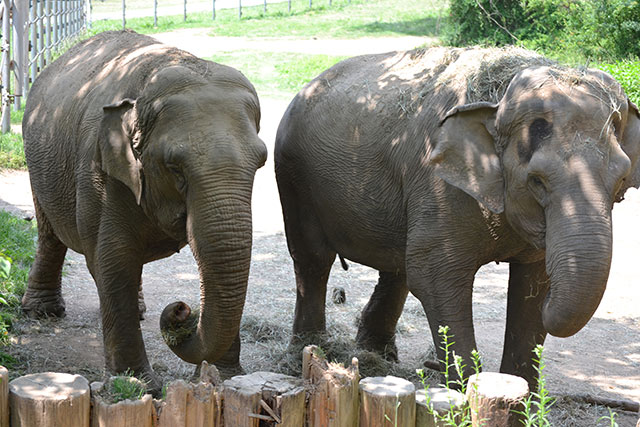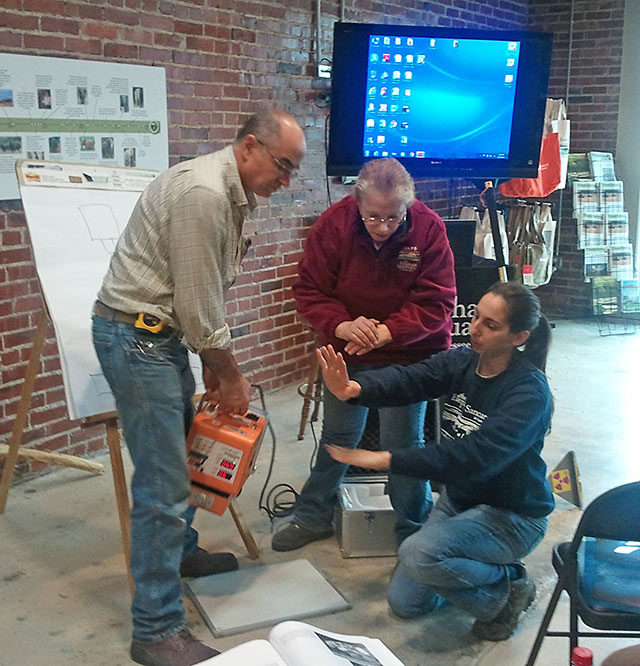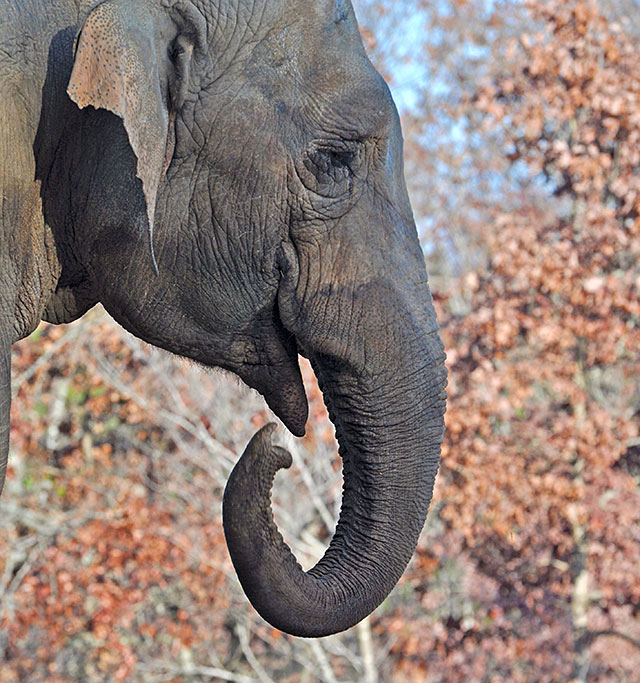
Billie and Frieda
This past week was an observance of the anniversary of many important events in the life of The Elephant Sanctuary in Tennessee. We celebrated the arrival anniversaries of Liz and Queenie (Feb 2, 2006), Debbie and Ronnie (Feb 7, 2006), Billie and Frieda (Feb 9, 2006); who all arrived, 2 by 2, in the 2006 Caravan to Freedom – the largest ever circus elephant rescue. This past Saturday we also remembered the life of Lota, who passed away from tuberculosis on Feb 9, 2005 after just a few short months of freedom in sanctuary.
These Q Girls' anniversaries are remembered each year, and we are thrilled that this year The Sanctuary has just completed new fencing in the Q-Habitat, opening up a new section of habitat for the Girls, the fruits of the 2012 Acres for Elephants campaign, which so many of you generously supported. The Sanctuary continues to grow and evolve, always using every resource at its disposal to provide the best life possible for the 14 elephants who call sanctuary home.
Saturday, we recognized the anniversary of the arrival of Billie and Frieda: Billie and Frieda completed their journey to Sanctuary on February 9, 2006. They were the last elephants to ride the “Caravan to Freedom” to a peaceful retirement in Tennessee. Both were born in Asia (Billie in 1953 and Frieda in 1966), separated from their families at a young age, and then sold into the circus industry in the United States. Billie was acquired by the Hawthorn Corporation, an organization that leased elephants to traveling circuses, at the age of 18. Frieda spent many years traveling with the Clyde-Beaty Cole Brothers Circus (along with fellow Sanctuary resident Debbie) before she, too, was sold to Hawthorn. Both Billie and Frieda had earned reputations as “dangerous” elephants during their circus days and were isolated in their new holding quarters.
Their arrival at the Sanctuary marked the completion of the successful transport of 10 Asian elephants from the Hawthorn Corporation to The Elephant Sanctuary in Tennessee, a move precipitated by USDA prosecutions against Hawthorn for the mistreatment of elephants. Lota and Misty were the pioneers, arriving in 2004, with Minnie, Lottie, Queenie, Liz, Debbie, Ronnie, Billie, and Frieda following in 2006. Frieda gained over 1000 pounds in her first 6 months at Sanctuary. This “aggressive” elephant is now very affectionate towards her caregivers and her sisters. Billie is celebrating her 60th birthday this year – an incredible milestone for an elephant living in captivity. In 2011, after five years of living at The Sanctuary, she finally allowed the chain around her ankle to be removed, the last physical vestige of her circus years.
Watch Billie’s Chain removal using Protected Contact training methods:
Frieda’s physical reminders from her circus career have proved much harder to remove. Elephant feet are designed to cover long distances over grassland and forest. It is common for elephants in captivity to develop a wide variety of foot problems affecting the bone, nails, and soft tissue, presumably due to the fact that they spend so much time standing on hard surfaces (concrete, pavement, etc). Frieda’s feet were in heartbreaking shape when she arrived, and while some elephants see marked improvement once they have ample access to natural substrates of the Sanctuary landscape, for some, like Frieda, the damage is permanent and must be tended to regularly, especially as elephants age.
To better identify problems going on inside the structure of Frieda’s feet, Dr. Mikota recommended that we prepare her for a radiograph. A radiograph is a form of an x-ray machine, designed to project radiographic beams through the subject area to be collected using a photo “plate” positioned on the other side of the area. By reconstructing the obstructions encountered during the beams’ journey, doctors can create a thorough and accurate picture of the anatomical landscape beneath the skin. Dr. Scott led a meeting between Elephant Care staff and the Director of Facilities to brainstorm all the positions necessary to perform the radiographs.

Dr. Scott, Vet Services Manager Deb, and Caregiver Kelly demonstrate Frieda’s limited mobility to Maintenance and Caregiver teams to brainstorm a design for a support system for Frieda.
This procedure requires an elephant to hold up her leg and keep it perfectly still at a specific angle for at least one second per shot – and multiple shots and multiple angles are required to accurately see the structure of an elephant’s foot. This is much more difficult than it sounds, especially for Frieda who has problems with all four of her feet and has limited mobility in her ankles. Because of the uniqueness of her condition, as Frieda inserts her foot through the opening in the protected contact fence for inspection and radio graphing, a special foothold support system was needed to be designed by Maintenance.
Caregiver Brianna has this to say on the subject: “Frieda is one of our sweetest elephants, and she is very cooperative. We’ve had to do a lot of footwork, requiring special treatments, and Frieda has been the picture of a perfect patient. She participates in her health care by allowing us to examine and treat her feet as necessary in order to care for her. This demonstrates the importance of positive reinforcement – having the elephants participate willingly in their own health care is vital, particularly here at Q Barn. Frieda is given special veggie treats during veterinary procedures, pedicures, and training. She is always willing to participate and give her absolute best effort.”
Frieda and Billie are our daily reminders to The Sanctuary’s belief that providing a healthy environment for the body and spirit of these animals helps them heal.

Dulary
In Asia: Update on Dulary
As reported in an earlier Ele-Note, Dulary has not been feeling well. She has been showing signs of discomfort for a while, which have been carefully monitored by both Vet Care and Caregiver staff. Caregiver Laurie expresses her concern: "It breaks my heart to see her uncomfortable; she vacillates between wanting to be alone and seeking out some comfort." In response to her difficulty, the Vet Team called in a veterinary consultation from the University of Tennessee. Currently, she is taking all meds and is in good spirits and is bright eyed, active, vocal, engaging, eating and drinking normally, according to Caregiver Laurie.
Dr. Scott performed a diagnostic EKG procedure on Dulary last week (and she is scheduled have another EKG this week just to double check the results). This procedure is carried out on elephants in much the same way as with humans. Sensory pads are placed at different locations on Dulary’s body, and the EKG machine collects readings on the electrical impulses generated by Dulary’s heart. This is all part of the comprehensive healthcare approach The Sanctuary is implementing to care for our aging population, and hopefully, these tests will provide some much needed insight into Dulary’s condition and help to determine our next steps forward.
Dulary is one of our four Girls who are all celebrating a milestone in 2013. Dulary celebrates her 50th birthday this year, and now, as we monitor this change in her health, our thoughts, the dedication of her Caregivers and Vet Care team, and the support of her sister elephants are in place for her.
Over at Q-Barn
Minnie is currently working on eating a tree in the creek bed. She pulls the branches down and holds them in her trunk while munching on the ends. Debbie and Ronnie continue to be inseparable best friends, even sleeping snuggled together in the barn. Liz has become the herd's predominant “explorer,” and the Sanctuary staff looks forward to having the fencing project completed, providing Liz with the opportunity to blaze new trails (or at least re-blaze old ones) in the habitat extension.
Thanks to all the members and supporters of the Elephant Sanctuary for making all of this work possible. Please take a moment to register for the e-Trunklines electronic newsletter for more info about goings-on at the Sanctuary, merchandise information, and other current events. We’ll be announcing the dates for the 2013 Volunteer Days via e-Trunklines very soon!
